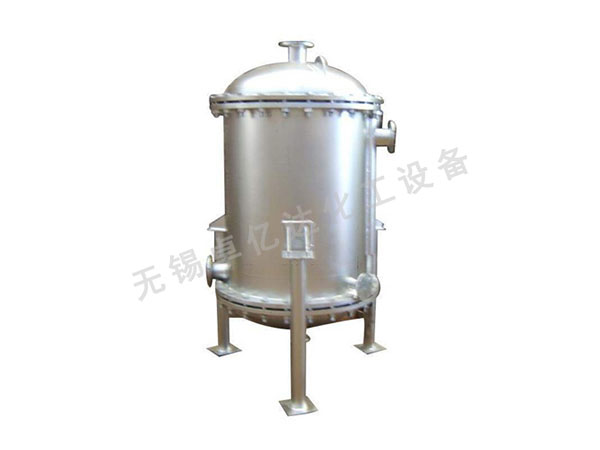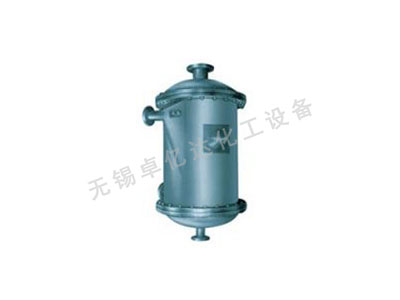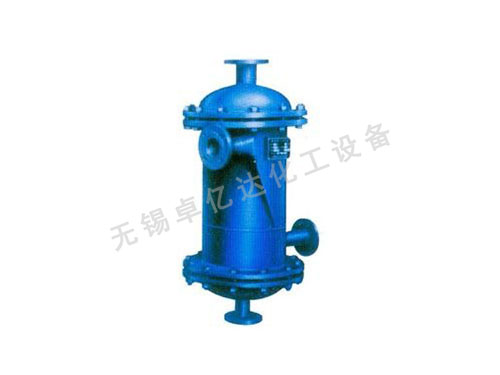
-
Spiral plate heat exchanger
- Type I non-detachable vertical spiral plate heat exchanger
- Type I non-detachable horizontal spiral plate heat exchanger
- Type Ⅲ horizontal detachable spiral plate heat exchanger
- Type Ⅲ vertical detachable spiral plate heat exchanger
- Type Ⅱ detachable spiral plate heat exchanger
- Stainless steel reactor
- Outer coil reactor
- Electric heating reactor
- Steam/thermal oil heating reactor
- Multifunctional dispersion kettle
- Unsaturated resin equipment
- Storage tank
- Distillation recovery tower
- JH series alcohol recovery tower
- Methanol/ethanol distillation unit
- Various towers
CONTACT
3 record 1/1 page
Structural features
1. High heat transfer efficiency
Because the type Ⅲ detachable spiral plate heat exchanger has spiral channels, the fluid flows in the channels, and the spiral plate is welded with fixed distance columns to maintain the width of the spiral channel or stamped fixed distance bubbles. Under the centrifugal force of the spiral flow cloud , Can make the fluid turbulent at a lower Reynolds number. Considering that the pressure drop will not be too large, it is more important to choose the channel width and fluid flow rate reasonably. Generally, a higher flow rate can be selected during design (the allowable design flow rate is about 2m/s for liquids and about 20m/s for gases), so that the fluid dispersion is high, the contact is good, and it is beneficial to improve the spiral plate heat exchanger Heat transfer efficiency. In recent years, many domestic units have carried out the measurement and comparison of the heat transfer coefficient of spiral plate and tube heat exchangers. For example, the auxiliary ammonia condenser of the refrigerator uses a type Ⅲ detachable spiral plate heat exchanger with a heat exchange area of F=30m² to replace a tube heat exchanger with a heat area of F=75m², which doubles the efficiency . Another example is the lower heater of the ammonia synthesis tower of a small chemical fertilizer plant. The original tubular structure is used, and the heat exchange area is F=30.9m². If it is replaced by a type Ⅲ detachable spiral plate heat exchanger, it only needs F=15.5m², and its efficiency is correspondingly improved. Doubled.
2. Effective use of fluid head loss
Although the fluid in the type Ⅲ detachable spiral plate heat exchanger does not have drastic changes in the flow direction and pulse phenomenon, because the spiral channel is long, the spiral plate is welded with fixed-distance columns. Under normal circumstances, this kind of heat exchanger The fluid resistance is larger than that of the shell-and-tube heat exchanger. However, compared with other types of heat exchangers, since the fluid is in a uniform spiral flow in the channel, the fluid resistance mainly occurs in the friction between the fluid and the spiral plate and the collision of the spacer, and this part of the resistance can cause The fluid is turbulent, so the heat supply system is correspondingly increased, which enables the type Ⅲ detachable spiral plate heat exchanger to effectively utilize the head loss of the fluid.
3. Not easy to foul
In recent years, many studies have focused on the fouling problem of heat exchangers, because fouling has a greater impact on the heat transfer effect of heat exchangers. In the type Ⅲ detachable spiral plate heat exchanger, since the medium goes through a single channel, its allowable speed can be higher than other types of heat exchangers, and dirt is not easy to deposit. If dirt is deposited somewhere in the channel, the cut area of the channel will be reduced. At a certain flow rate, if the cross-sectional area is reduced, the local flow velocity will increase accordingly, which will wash away the dirt area. In a shell-and-tube heat exchanger, if a heat exchange tube has dirt deposits, the local resistance of the heat exchange tube increases, the flow rate is restricted, the flow velocity decreases, and the medium is shunted to other heat exchange tubes to make the heat exchange The resistance of each heat exchange tube in the device is rebalanced, so that the flow rate of the heat exchange tube deposited with dirt becomes lower and lower, and the easier it is to settle and become completely blocked. The shell and tube heat exchanger used in chemical plants and oil refineries often has dirt deposits on the inner diameter of the tube, which is prone to tube blockage. In the type Ⅲ detachable spiral plate heat exchanger, it has a self-washing effect. The fouling formation speed is about 1/10 of the shell-and-tube heat exchanger.
When clogging occurs, pickling or hot water cleaning is often used abroad, and steam blowing is mostly used in China, which is more convenient and efficient than hot water cleaning.
4. Ability to use low-temperature heat sources and accurately control the outlet temperature. In order to improve the heat transfer efficiency of the Type Ⅲ detachable spiral plate heat exchanger, it is required to increase the heat transfer driving force. When the two fluids adopt full countercurrent operation in the spiral channel, the logarithmic average temperature difference of the two fluids is relatively large, which is favorable for heat transfer. Based on the analysis of the empirical data used in the design of the heat exchanger, the allowable min temperature difference of type Ⅲ detachable spiral plate heat exchanger is low, and heat exchange can still be carried out when the temperature difference between the two fluids is 3℃. Due to the low allowable temperature difference, countries all over the world use this type of heat exchanger to recover low-temperature heat energy.
Type Ⅲ detachable spiral plate heat exchanger has two long uniform spiral passages. The medium can be evenly heated and cooled in the passages, so its outlet temperature can be accurately controlled.
5. Compact structure
A type Ⅲ detachable spiral plate heat exchanger with a diameter of 1.5m and a width of 1.8m has a heat transfer area of up to 200m², and the heat transfer area per unit volume is about 3 times that of a shell-and-tube heat exchanger.
6. Reliable sealing structure
The two channel ends of the currently used Ⅲ detachable spiral plate heat exchanger are welded and sealed (non-detachable) and end caps are compressed (detachable). The non-detachable type can ensure that there is no internal leakage between the two media while ensuring the welding quality. The two ends of the detachable type are compressed with end caps, and the end caps are provided with integral sealing plates. As long as the two ends of the spiral channel are processed smoothly, the same side fluid can be prevented from flowing from one circle to another.
7. Small temperature difference stress
The type Ⅲ detachable spiral plate heat exchanger is characterized by allowing expansion. Because it has two long spiral passages, when the spiral plate is heated or cooled, it can stretch and contract like a clockwork. The spiral body has hot fluid on one side and cold fluid on the other side, and the outer ring is in contact with the atmosphere. The temperature difference between the spirals is not as obvious as the temperature difference between the heat exchange tube and the shell in a shell-and-tube heat exchanger, so there is no large temperature difference stress.
Technical parameter
1. High heat transfer efficiency
Because the type Ⅲ detachable spiral plate heat exchanger has spiral channels, the fluid flows in the channels, and the spiral plate is welded with fixed distance columns to maintain the width of the spiral channel or stamped fixed distance bubbles. Under the centrifugal force of the spiral flow cloud , Can make the fluid turbulent at a lower Reynolds number. Considering that the pressure drop will not be too large, it is more important to choose the channel width and fluid flow rate reasonably. Generally, a higher flow rate can be selected during design (the allowable design flow rate is about 2m/s for liquids and about 20m/s for gases), so that the fluid dispersion is high, the contact is good, and it is beneficial to improve the spiral plate heat exchanger Heat transfer efficiency. In recent years, many domestic units have carried out the measurement and comparison of the heat transfer coefficient of spiral plate and tube heat exchangers. For example, the auxiliary ammonia condenser of the refrigerator uses a type Ⅲ detachable spiral plate heat exchanger with a heat exchange area of F=30m² to replace a tube heat exchanger with a heat area of F=75m², which doubles the efficiency . Another example is the lower heater of the ammonia synthesis tower of a small chemical fertilizer plant. The original tubular structure is used, and the heat exchange area is F=30.9m². If it is replaced by a type Ⅲ detachable spiral plate heat exchanger, it only needs F=15.5m², and its efficiency is correspondingly improved. Doubled.
2. Effective use of fluid head loss
Although the fluid in the type Ⅲ detachable spiral plate heat exchanger does not have drastic changes in the flow direction and pulse phenomenon, because the spiral channel is long, the spiral plate is welded with fixed-distance columns. Under normal circumstances, this kind of heat exchanger The fluid resistance is larger than that of the shell-and-tube heat exchanger. However, compared with other types of heat exchangers, since the fluid is in a uniform spiral flow in the channel, the fluid resistance mainly occurs in the friction between the fluid and the spiral plate and the collision of the spacer, and this part of the resistance can cause The fluid is turbulent, so the heat supply system is correspondingly increased, which enables the type Ⅲ detachable spiral plate heat exchanger to effectively utilize the head loss of the fluid.
3. Not easy to foul
In recent years, many studies have focused on the fouling problem of heat exchangers, because fouling has a greater impact on the heat transfer effect of heat exchangers. In the type Ⅲ detachable spiral plate heat exchanger, since the medium goes through a single channel, its allowable speed can be higher than other types of heat exchangers, and dirt is not easy to deposit. If dirt is deposited somewhere in the channel, the cut area of the channel will be reduced. At a certain flow rate, if the cross-sectional area is reduced, the local flow velocity will increase accordingly, which will wash away the dirt area. In a shell-and-tube heat exchanger, if a heat exchange tube has dirt deposits, the local resistance of the heat exchange tube increases, the flow rate is restricted, the flow velocity decreases, and the medium is shunted to other heat exchange tubes to make the heat exchange The resistance of each heat exchange tube in the device is rebalanced, so that the flow rate of the heat exchange tube deposited with dirt becomes lower and lower, and the easier it is to settle and become completely blocked. The shell and tube heat exchanger used in chemical plants and oil refineries often has dirt deposits on the inner diameter of the tube, which is prone to tube blockage. In the type Ⅲ detachable spiral plate heat exchanger, it has a self-washing effect. The fouling formation speed is about 1/10 of the shell-and-tube heat exchanger.
When clogging occurs, pickling or hot water cleaning is often used abroad, and steam blowing is mostly used in China, which is more convenient and efficient than hot water cleaning.
4. Ability to use low-temperature heat sources and accurately control the outlet temperature. In order to improve the heat transfer efficiency of the Type Ⅲ detachable spiral plate heat exchanger, it is required to increase the heat transfer driving force. When the two fluids adopt full countercurrent operation in the spiral channel, the logarithmic average temperature difference of the two fluids is relatively large, which is favorable for heat transfer. Based on the analysis of the empirical data used in the design of the heat exchanger, the allowable min temperature difference of type Ⅲ detachable spiral plate heat exchanger is low, and heat exchange can still be carried out when the temperature difference between the two fluids is 3℃. Due to the low allowable temperature difference, countries all over the world use this type of heat exchanger to recover low-temperature heat energy.
Type Ⅲ detachable spiral plate heat exchanger has two long uniform spiral passages. The medium can be evenly heated and cooled in the passages, so its outlet temperature can be accurately controlled.
5. Compact structure
A type Ⅲ detachable spiral plate heat exchanger with a diameter of 1.5m and a width of 1.8m has a heat transfer area of up to 200m², and the heat transfer area per unit volume is about 3 times that of a shell-and-tube heat exchanger.
6. Reliable sealing structure
The two channel ends of the currently used Ⅲ detachable spiral plate heat exchanger are welded and sealed (non-detachable) and end caps are compressed (detachable). The non-detachable type can ensure that there is no internal leakage between the two media while ensuring the welding quality. The two ends of the detachable type are compressed with end caps, and the end caps are provided with integral sealing plates. As long as the two ends of the spiral channel are processed smoothly, the same side fluid can be prevented from flowing from one circle to another.
7. Small temperature difference stress
The type Ⅲ detachable spiral plate heat exchanger is characterized by allowing expansion. Because it has two long spiral passages, when the spiral plate is heated or cooled, it can stretch and contract like a clockwork. The spiral body has hot fluid on one side and cold fluid on the other side, and the outer ring is in contact with the atmosphere. The temperature difference between the spirals is not as obvious as the temperature difference between the heat exchange tube and the shell in a shell-and-tube heat exchanger, so there is no large temperature difference stress.
Technical parameter
| Device model | Nominal heat transfer aream2 | Outer diameter D | Equipment height | Center distance of support screw hole φ≈mm | Channel spacing mm | Nominal diameter of takeover Dg | Flow rate 1mces capacity m3/h | Equipment weight Kg |
| Ⅲ 6B4-0.5/350-6 | 4 | 334 | 1155 | 605 | 6 | 60 | 10 | 189 |
| Ⅲ 6B4-0.5/450-10 | 4 | 388 | 1205 | 660 | 10 | 80 | 17.3 | 223 |
| Ⅲ 6B5-0.5/450-10 | 5 | 401 | 1205 | 672 | 10 | 80 | 17.3 | 261 |
| Ⅲ 6B8-0.5/400-6 | 8 | 420 | 1180 | 691 | 6 | 60 | 10.4 | 307 |
| Ⅲ 6B10-0.5/550-10 | 10 | 564 | 1255 | 860 | 10 | 80 | 17.3 | 450 |
| Ⅲ 6B15-1.0/500-10 | 15 | 520 | 1930 | 816 | 10 | 100 | 35.3 | 534 |
| Ⅲ 6B20-1.0/700-14 | 20 | 681 | 1930 | 1008 | 14 | 125 | 44.2 | 820 |
| Ⅲ 6B25-1.0/750-14 | 25 | 747 | 1955 | 1073 | 14 | 125 | 44.2 | 987 |
| Ⅲ 6B30-1.0/850-14 | 30 | 847 | 2005 | 1170 | 14 | 130 | 49.4 | 1181 |
| Ⅲ 6B40-1.0/1000-14 | 40 | 981 | 2080 | 1441 | 14 | 130 | 49.4 | 1540 |
| Ⅲ 6B50-1.0/1100-14 | 50 | 1103 | 2130 | 1560 | 14 | 130 | 49.4 | 2140 |
| Ⅲ 6B60-1.2/1100-16 | 60 | 1160 | 2330 | 1637 | 16 | 150 | 63.97 | 2490 |
| Ⅲ 6B80-1.0/1400-14 | 80 | 1413 | 2280 | 1873 | 14 | 150 | 49.4 | 2985 |
| Ⅲ 6B100-1.2/1400-14 | 100 | 1390 | 2480 | 1850 | 14 | 150 | 59.5 | 3492 |
| Ⅲ 6B120-1.5/1500-18 | 120 | 1517 | 3030 | 1997 | 18 | 200 | 96.0 | 4197 |
| Ⅲ 6B150-1.5/1700-18 | 150 | 1700 | 3130 | 2151 | 18 | 200 | 96.0 | 5247 |


